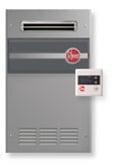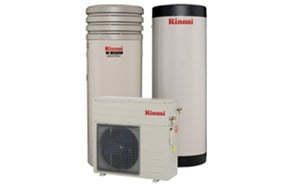Key Takeaways
- Storage systems keep a tank of hot water ready (reheat time 30–90 min).
- Instantaneous systems heat on demand. No tank, high flow requirement.
- Heat pumps move heat from air to water using electricity efficiently.
- Solar-boosted use roof collectors + electric/gas boost.
- Safety controls: tempering valve limits tap temperature; PTR valve relieves pressure.
Demystifying the Process: What does a hot water system do?
In the following FAQ, “How Hot Water Systems Work,” we unravel the intricacies of heating water efficiently for your daily needs. Australian Hot Water provides an insightful guide to help you understand the inner workings of hot water systems, demystifying the technology behind heating water for various applications. From traditional tank-based systems to modern tankless solutions, we explore the mechanisms that ensure a constant and reliable supply of hot water. Whether you’re a homeowner or a business owner, this FAQ blog equips you with valuable insights into the science of heating water, making your experience with hot water systems seamless and efficient.
What does a hot water system do?
Every system takes cold water, applies heat (or moves it, in a heat pump), and delivers it at a safe temperature to your taps. In Australia, most homes use one of five types:
- Electric storage (resistive element in a tank)
- Gas storage (burner + flue, tank)
- Gas instantaneous (continuous flow, no tank)
- Heat pump (uses ambient air heat, with a tank)
- Solar-boosted (roof collectors + electric/gas boost, with a tank)
The Main System Types
Storage vs instantaneous — A quick comparison
| Feature | Storage (Electric/Gas) | Instantaneous (Gas/Electric) |
|---|
| How it heats | Heats and stores water in a tank | Heats as you use it, no tank |
| Hot water duration | Limited by tank size; reheats in 30–90 min | Continuous within unit capacity |
| Space | Larger cylinder | Compact wall unit |
| Power/gas use | Lower input, steady; suits off-peak | High input during flow |
| Best for | Steady demand, families, off-peak tariffs | Small spaces, variable/low simultaneous demand |
Hot water systems are differentiated by two main factors. The first factor is the power source of the system. The primary power sources of hot water systems are electricity and gas. However, solar hot water systems are becoming more and more popular for their energy efficiency, while heat pump systems are the cutting edge of renewable and efficient hot water production.
The second factor that differentiates hot water system types is whether they are tank-based systems or instantaneous systems. A tank system maintains a large amount of water in a tank that is then refilled as hot water is used. An instantaneous hot water system heats hot water on demand, without keeping any stored supply.
We will go through each of these types in more detail below.
Electric storage: how it works
A thermostat energises an immersion element inside an insulated tank. Cold water enters near the bottom; hot water is drawn from the top. As hot water is used, the tank refills with cold water and reheats.
Pros: simple, low upfront cost, quiet.
Cons: higher running costs than heat pump/solar; off-peak timing may delay heating.
Gas storage: how it works
A gas burner under the tank heats the water; a flue vents combustion gases. Older units have a standing pilot; many newer models use electronic ignition.
Pros: faster recovery than electric storage.
Cons: flue/ventilation requirements; efficiency lower than heat pump.
Gas instantaneous (continuous flow): how it works
A flow sensor detects demand when you open a hot tap. The burner fires and heats water through a heat exchanger. No tank means no standby losses.
Pros: “endless” hot water; compact.
Cons: needs minimum flow/pressure to ignite; capacity limits simultaneous outlets (e.g., 16–26 L/min models).
Heat pump: how it works
A refrigeration cycle moves heat from the air to the tank: evaporator → compressor → condenser coil → expansion device. It uses electricity but far less than a resistive element.
Pros: very efficient, lower running costs.
Cons: fan/compressor noise; performance varies with ambient temperature.
Solar-boosted: how it works
Solar collectors on the roof heat water (or a transfer fluid). Heat rises to the tank (thermosiphon) or is moved by a pump (split system). An electric/gas boost covers low-sun periods.
Pros: lowest running costs in sunny climates.
Cons: higher upfront cost; needs correct sizing and boost strategy.
Safety controls and normal operation
Tempering valve: mixes cold water to keep the bathroom delivery ≤50 °C.
PTR valve: relieves excess pressure/temperature; brief dripping during heating is normal.
What’s not normal: continuous heavy discharge, sulphur/gas smells, breaker tripping, loud banging—book a licensed plumber.
Sizing & recovery time (what to expect)
Storage tanks: choose capacity for peak demand (e.g., morning showers). Expect 30–90 min to reheat after a large draw.
Instantaneous: choose by L/min rating at a given temperature rise; ensure gas/electrical supply matches specs.
Heat pump/solar: ensure tank size and boost strategy match climate and usage.
Running costs & tariffs (at a glance)
- Electric storage: can run on off-peak tariffs; higher kWh use than heat pump/solar.
- Heat pump: lowest electricity use for electric options.
- Gas (storage/instantaneous): fuel cost varies by region; instantaneous fires only on demand.
- Solar-boosted: minimises energy use when sun is available; boost fills the gap.
Electric systems simply work by connecting the tank to your home’s regular electricity supply. For very small tanks, this can sometimes be done by plugging the tank into a normal power outlet in your wall. However, for larger tanks that require higher currents of electricity, they require a fixed integration into your home’s electrics.
An electric hot water system employs an ‘element’, which is either made from copper or ‘Incoloy’ (nickel-chrome alloy) with an inner wire running through it. The system passes an electrical current through the wire to create friction and therefore heat. This makes the element extremely hot and it begins to heat the water in the tank.
A gas hot water system requires that your home be connected to either the natural gas mains supply in your street which is not always available in all areas, or LPG bottle gas independent to your home.
A gas system employs a burner, which ignites the gas as it enters the system. A gas heater also requires a flue to remove combustion gases from the system.
Gas systems are generally more efficient than electric systems and cheaper to run. However, they are also generally more expensive to buy off the shelf.
An instant – also known as instantaneous, tank-less, or continuous flow – hot water system does not require any tank as it does not store any water. An instant system simply heats water as and when it is needed.

It works by passing water through a copper pipe – usually coiled within a heat exchanger – that is heated either by an electric element or a gas burner. The water is immediately heated as it passes through and is sent directly to the water outlet.
Since an instant hot water system does not waste any energy keeping a large amount of water hot when it is not in use, it is generally much more energy efficient than a tank-based system. However, they are generally also more expensive to buy and install.
Instant hot water systems come in different sizes, which dictate how much hot water the system can produce on demand.
A solar hot water system works by capturing heat from the sun and transferring it to water that is then channelled on to water outlets in the home. There are different ways in which this process occurs, however.
The most straightforward method is that solar panels attached to the roof of your home collect heat and transfer it to a water storage tank on the ground. However, solar tanks can also be mounted onto roofs, while some solar systems channel water through tubes near the solar panels so as to give them the added benefit of direct heating from the sun.

In almost all cases, a solar system is integrated with either a gas or electric booster. Since solar power is dependent upon the weather, it is necessary sometimes to use a secondary energy source to quickly heat water to meet demand. A solar system can typically provide around 60% of your hot water needs. However, figures will vary depending upon the location of your home, the type of system, as well as the configuration of your roof.
Solar systems are more expensive to buy and install than regular hot water systems. However, they are far cheaper to run since their energy source is available for free. Also, solar panels are very enduring so that they can be relied upon for significant periods of time.
A heat pump hot water system represents the cutting edge of water heating technology. Like a solar system, the heat pump hot water heater uses renewable energy.
The way that a heat pump works is that it collects air from directly around it and then circulates it through the pump. By circulating it, the heat of the air increases and this heat is then channelled towards the water reserve.
In this way, the heat pump system is attached to a water tank as in a regular hot water system. However heat pump systems are regarded as being two to three times more energy efficient than a standard electric hot water heater.
As with a solar system, the heat pump also comes with either a gas or electric power source. This allows the heat pump to bring in the warm air for circulation and also to boost the heating power of the machine when it is in demand.
The efficiency of a heat pump system is dependent upon the positioning of the pump, the climate in which you live, as well as the specifications of the individual device.
Hot water heaters have been benefiting from the development of technological advances for a long time now. Not only are new technologies like solar and heat pump systems being created, but older types of systems are becoming more and more efficient. So, hot water heaters are working better and better all the time.

There is no simple answer to the question of which hot water heater works the best. The way in which different hot water systems work will be better suited to different needs and situations. For example, not all homes will be compatible with a solar hot water system because the aspect of the roofing does not allow much exposure to sunlight. On the other hand, homes with intermittent hot water usage may be better suited to the way an instant hot water system works – only heating water as and when it is needed.
If you require further guidance on how different types of hot water systems work and which is best for you, you can get in touch with one of Australian Hot Water’s expert advisers. A hot water system represents a significant investment, since you will keep it for a very long time. So, make sure you get the information you need to make the right decision for what is most appropriate for you and your family.


